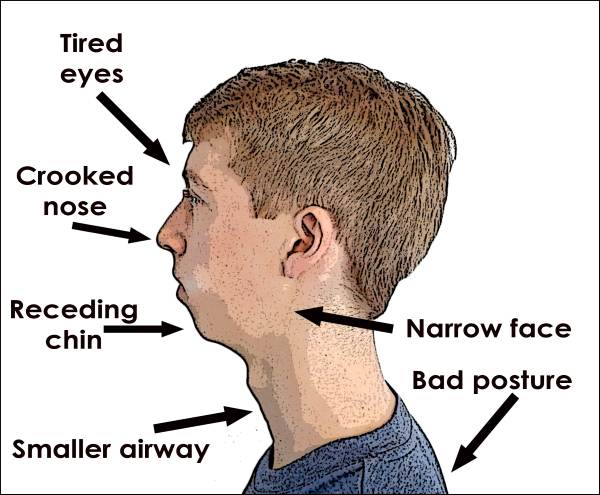“Adverse effects on facial growth and physiological health can be dramatic if breathing dysfunction untreated.”
Whilst the trend for breathwork is on the increase, breath re-educator Joel Jelen spends a great deal of his working life sharing how many health care professionals in the UK are unaware of the negative impact of upper airway obstruction and mouth breathing on normal facial growth and our physiological health.
Ultimately, Jelen is talking about mouth breathing here amongst children and his view is supported by the likes of eminent physicians including Dr. Yosh Jefferson.
He produced a paper entitled Mouth breathing: adverse effects on facial growth, health, academics, and behaviour and to Jelen, the symptoms are all too familiar.
In it, Jefferson notes how children whose mouth breathing is untreated may develop long, narrow faces, narrow mouths, high palates, and dental malocclusion.
Jelen realised he was a mouth breather at an early age, but his family doctors overlooked the condition.
After corrective surgery for a deviated septum in the early eighties, Jelen’s related over breathing symptoms and quest to meet an appropriate doctor continued until he met Dr Len McEwan in 1995 who Jelen says “changed my life.”
“I was approaching 30 then but still determined! And when I met Dr McEwan, he proved to be a revelation. He was dubbed the founding father of hyperventilation syndrome, something I recognised I suffered from as a kid.”
Jefferson echoes much of what McEwan was telling private clients in the nineties.
“Mouth breathing children sleep poorly at night owing to obstructed airways that can affect their growth and academic performance. Often, many are misdiagnosed with ADHD.
Nose breathing is the only way to breathe

Jelen continued: “I remember what Dr McEwan said about the importance of early intervention where possible and again Jefferson emphasises this.”
He added: “It is important for the entire health care community (including general and paediatric dentists) to screen and diagnose for mouth breathing in adults and in children as young as 5 years of age. If mouth breathing is treated early, its negative effect on facial and dental development and the medical and social problems associated with it can be reduced or averted”.
In his personal wellbeing journey and some 20 years later, Jelen joined the now army of followers that Patrick McKeown enjoys, linking up with him for a week in 2016. As a result, he became a Certified Breath Re-Educator and Fellow of Buteyko Professionals International.
Kids mouth breathing in their sleep becomes habitual

“Patrick is what I would term “ferociously holistic. He has the same outlook that Dr. McEwan had and with the same determination to help the public become aware of what is, in essence, a hidden epidemic of dysfunctional breathing.
“He inspired me to publish my first book recently too called ‘Why Does Daddy Breathe Funny’ told through the eyes of Esther. In precociously pointing out her daddy’s (and mummy’s) breathing issues, Esther then discovers that she too hyperventilates, and mouth breathes.”
Jelen maintains that pointing out those who mouth breathe and its effects on childhood development is nothing new.
“I learnt from Patrick’s Buteyko Clinic that an article was published in 1909 called The Dental Cosmos in which the writer described how mouth breathing affects the development of the face and skull. Children who mouth-breathe, the author explained, are often misinterpreted as being inattentive in class due to their ‘glazed’ expressions. The fact is, there is significant scientific evidence that mouth breathing can lead to poorly developed airways, contributing to a lifelong habit of poor breathing patterns.
“Patrick will tell you that there is also plenty of evidence that mouth breathing causes learning difficulties.”
But what causes someone to mouth breathe?
“Mouth breathing in children is generally caused by some sort of obstruction in the airways or by narrow airways and then it becomes habitual,” says Jelen.
“I’ve seen enough toddlers with untreated swollen adenoids that can lead to long term abnormalities in facial growth.
“But there’s also a multitude of factors that contribute to mouth breathing including asthma, thumb sucking, a high narrow arch (palate), tongue and lip-tie.
“Factors can be environmental too with central heating in homes often exacerbating symptoms of children mouth breathing.”
Symptoms of long term mouth breathing

Whilst many of us are complaining about another below par summer in the UK, some of those same people will be thankful given how ‘allergic rhinitis’ rears its ugly head in the form of hay fever at this time of year.
About 40 percent of children are affected by rhinitis with symptoms including nasal discharge, sneezing, blocked nose, palate itching, mood swings and tiredness.
“These are common amongst children who mouth-breathe and can be relieved by learning to breathe through the nose,” insists McKeown.
Jelen concludes: “One of the key tasks for parents is to monitor their child in two different scenarios…at sleep and during bouts of concentration. If they are mouth breathing extensively in either, seek expert help.”
Joel Jelen is the founder of Sniff Sigh Yawn which helps companies with breathwork-led workplace performance programmes alongside his team. He also delivers events to community organisations and works with private clients to help share the message of breathing better for vitality.
Want to learn how to get your children and teenagers to stop mouth breathing?
Sniffsighyawn.com
Buteykoclinic.com
https://www.amazon.co.uk/Why-Does-Daddy-Breathe-Funny/dp/B0CCZZX2XL
Jelen’s breathing book has been a hit amongst nurseries, schools and colleges alike

References:
Mouth breathing and facial growth:
Jefferson Y. Mouth breathing: adverse effects on facial growth, health, academics, and behaviour. Gen Dent. 2010 Jan-Feb;58(1):18-25; quiz 26-7, 79-80.
Child Facial Development:
DeLong, G.F. Smith, John. “Habitual Mouth-Breathing and Consequent Malocclusion of the teeth.” The Dental cosmos; a monthly record of dental science
Narrow palate effects:
https://www.ncbi.nlm.nih.gov/pmc/articles/PMC9922614/
Allergic Rhinitis and ADHD:
https://www.nature.com/articles/s41598-018-28702-5
Mouth breathing & academia: www.researchgate.net/publication/285907265_The_influence_of_mouth_breathing_on_reading_and_writing_learning_in_preschool_children
Swollen Adenoids:
Eom, Tae-Hoon, Eun-Sil Jang, Young-Hoon Kim, Seung-Yun Chung, and In-Goo Lee. “Articulation error of children with adenoid hypertrophy.” Korean journal of paediatrics



